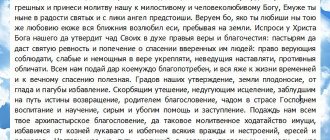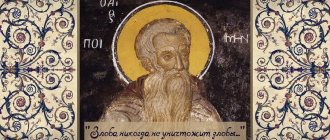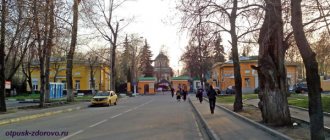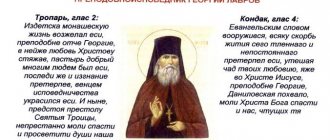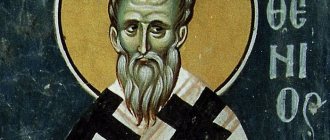VARLAAM KHUTYNSKY
Saints Varlaam of Khutyn, John the Merciful, Paraskeva Pyatnitsa and Anastasia with Our Lady of the Sign. Icon. 2nd half XV century (GRM)
Saints Varlaam of Khutyn, John the Merciful, Paraskeva Pyatnitsa and Anastasia with Our Lady of the Sign. Icon. 2nd half XV century (GRM)
V.H. is represented by numerous miniatures, monuments of icon painting, monumental painting, sewing, applied art, graphic drawings, and engravings that reflect the general Russian culture. the nature of the veneration of the saint. Most of the images have been preserved in works of Novgorod and Moscow art. In the iconographic tradition of V.Kh., several can be distinguished. main options. The earliest type of image is the one-person frontal image of V.Kh., which dates back to the not extant. time for the tombstone portrait of the saint. The half-length version of this excerpt was reproduced on the hegumen seals of the Khutyn Monastery starting from the 1st decade of the 15th century. (for the first time - on the seal of Abbot Varlaam). The monk is represented in a doll, with a rolled scroll (?) in his hand (GIM, GE). Obviously, icons depicting the saint were painted in Novgorod even before the archbishop’s examination. Euthymius of the relics of V. Kh. (1440), since the above-mentioned abbot. Varlaam, having become the archimandrite of the Yuryev Monastery, already in 1410 built a gateway church in the Lissitzky Monastery. in the name of V.Kh., where his image was to be placed next to the royal doors. Since at the same time (between 1408-1422 and 1438) the 2nd edition of the life of the saint appeared, usually accompanied by the painting of an icon and the laying of a cover on the tomb, one should assume a more ancient composition of the iconography of V. Kh. To the most ancient iconographic type of V. Kh. include his images on sewn covers, known to us from monuments of the 16th century. In the Moscow workshop of Tsarina Irina Godunova there was a sewn cover placed in the Khutyn Monastery in 1579, on which V. Kh. is represented in the schema, on the head of a doll with the Calvary cross, in the hands of a rolled scroll (NGOMZ; earlier covers from the Khutyn monastery are known from the description (Makariy (Mirolyubov), Archbishop. Archaeological description of church antiquities in Novgorod and its environs. M., 1860. T. 2. P. 305-308). Large temples belong to the same tradition icons of the monk, their iconography differs only in details: a doll worn or lowered over the shoulders, a closed or open scroll, the content of the text written on it.Such an icon of the 16th century in the refectory of Ts. Varlaam of the Khutyn Spaso-Preobrazhensky Monastery is mentioned by Archbishop. Macarius: “In the left hand of the monk there is a scroll with the inscription: “Brothers, for this you are tired, strive for this and do not be negligent about your salvation; and may our Lord Jesus Christ keep you in His love; even if I depart from you physically , but I will be persistent with you in spirit, and let it be reasonable about everything, if I have found grace before God, a monastery even after my death, as in my life, no one else’s” (Ibid. P. 80. Note. 153). A carved image of the monk has been preserved, decorating the top cover of a wooden reliquary from the Dimitrievskaya Church. in Novgorod (mid-16th century (1560?), NGOMZ), where V. Kh. is depicted without a doll, with a forked beard, blessing, with an unfolded scroll in his hands with the text: “Blessed is the man who remembers my name on the day of remembrance mine." The same image of the saint (along with his presence before the Savior in the Deesis composition) is found in the middles of hagiographic icons.
Reverend Sergius of Radonezh and Varlaam of Khutyn, St. Khariton the Confessor. Icon from St. Sophia Cathedral in Novgorod. Con. XV - beginning XVI century (NGOMZ)
Reverend Sergius of Radonezh and Varlaam of Khutyn, St. Khariton the Confessor. Icon from St. Sophia Cathedral in Novgorod. Con. XV - beginning XVI century (NGOMZ)
The earliest surviving image is the image of V. Kh. together with the saints, whose days of remembrance are close, on the Novgorod icon of the 2nd floor. XV century “Saints Barlaam of Khutyn, John the Merciful, Paraskeva Pyatnitsa and Anastasia with the Mother of God “The Sign” (Russian Russian Museum). The saint is presented frontally, he is wearing a golden-ocher cassock, a light green schema with a folded-back cowl and a violet-brown mantle, holding a rolled scroll with both hands. On the tablet from the set of calendars of the St. Sophia Cathedral, the monk is presented in the center of the reverse side (on the front - “The Exaltation of the Cross”) between the saints Chariton the Confessor, Bishop. Iconium, and Sergius of Radonezh. He is depicted in a dark cherry robe and a yellow cassock, a doll, blessing, with a scroll in his hand (NGOMZ). Later, especially in the 16th century, this version of the image of the monk would be the most common. From the 2nd half. XV century up to the end XVII century on Moscow and Novgorod icons V. Kh. is often represented with St. Sergius of Radonezh. For Novgorodians, V.Kh. personified the glory of local history, the spiritual origin of the Novgorod church and monastic life, just as in Moscow the same ideas were associated with the name of St. Sergius of Radonezh. The earliest image is a fresco from the east. house walls in the name of St. Sergius of Radonezh, Archbishop. Jonah in Novgorod Detinets (between 1460 and 1463). The embroidered decoration of the white hood of Vasily, Archbishop, dates back to the same time. Novgorod, decorated after 1478 with pellets with 3 Russian figures. saints: V. Kh., Sergius of Radonezh and Cyril of Belozersky (Ibid. p. 347). On the Novgorod icon “Selected Saints” (1560, Tretyakov Gallery) on the left side of the Mother of God “The Sign” there are half-length figures of V. Kh. (in the schema) and St. Sergius of Radonezh, both with scrolls. In the XVI-XVII centuries. there was a version of Pyadnik icons with images of these 2 saints (“Saints Barlaam and Sergius of Radonezh”, late 16th century, Russian Museum). The numerous images of V.Kh. on the margins of icons of different versions are characterized by the same principle: the saint is most often presented in a pair or next to the saint. Sergius of Radonezh, for example. on the Moscow icon “Our Lady Hodegetria with the Holy Trinity and Selected Saints” (last quarter of the 15th century, Tretyakov Gallery). The image of V. Kh. often appears on icons with saints in the margins as part of other saints: the half-length frontal image of V. Kh. in a medallion is presented on the lower field of the embroidered sovereign “Appearance of the Mother of God to St. Sergius of Radonezh” (last quarter of the 15th century, GMZMK). To the beginning XVI century One can note the convergence of the appearances of V. Kh. and others. Sergius of Radonezh, as evidenced, for example, by the image on the mentioned wooden reliquary of 1560.
Our Lady Hodegetria with the Holy Trinity and selected saints. Icon from the Holy Trinity Lavra of St. Sergius. Last Thursday XV century Master Dionysius (TG)
Our Lady Hodegetria with the Holy Trinity and selected saints. Icon from the Holy Trinity Lavra of St. Sergius. Last Thursday XV century Master Dionysius (TG)
During the XVI-XVII centuries. The frontal image of the monk is often presented with Novgorod saints, for example. on an embroidered veil, gray XVI century together with the Novgorod saints John and Nikita, Jonah of Otensky, Euthymius Vyazhitsky, overshadowed by the spiritual symbol of Novgorod - the image of the Mother of God “The Sign” (embroidered in the Stroganovs’ workshop and enclosed by D. A. Stroganov in the Khutyn Monastery, now in the NGOMZ). The special attitude of the Novgorodians towards the memory of the saint is evidenced by the fact that already in 1645, on the place where, according to legend, the parents of the saint lived, a chapel was built in honor of V.Kh., decorated with his icon, and in 1679 in it a stone cross was installed with images of the “Crucifixion” and V. Kh. (Makariy (Mirolyubov), archimandrite. Inventory of the Novgorod Spaso-Khutyn Monastery of 1642 // ZORSA. 1857. T. 9. P. 406. Note 1).
A special iconographic type of the upcoming or praying V.Kh. developed with the introduction of his image into the Deesis rite. Such icons became widespread primarily in Novgorod art (icon from the iconostasis of the Assumption Church of the Kolmov Monastery near Novgorod, c. 1530, NGOMZ), most often the saint is depicted in pairs with St. Sergius of Radonezh, for example. on the Deesis icons (c. 1558) of the iconostasis c. Apostles Peter and Paul in Kozhevniki in Novgorod (NGOMZ). Deesis icons of the 16th-17th centuries. with the image of V.Kh. are known in the museums of Novgorod and Pskov (both 1550, NGOMZ, PIAM; not cleared). In the upcoming V.Kh. is often depicted among the Russians. saints in front of the miraculous image of the Mother of God or in front of the holiday icons: on the shroud “Our Lady of the Burning Bush, with selected saints” (late 15th - early 16th centuries, Russian Museum) - next to St. Sergius of Radonezh. Together with Rev. Anthony the Roman depicts him praying to the icon of the Mother of God “The Sign” on the fresco of the central wall of the south. walls of the Transfiguration Cathedral of the Khutyn Monastery (Ibid. p. 411). Paired with the same saint, V. Kh. appears before the Lord Almighty on a double-sided icon, written by the master G. Semyonov on a piece of stone - a relic of St. Anthony the Roman (XVIII century, Russian Museum). On a number of icons, V.Kh. appears in prayer to Christ (or the Mother of God) together with St. Procopius of Ustyug (XVI century, AMI; XVII century, Tretyakov Gallery); on the icon from Kargopol with Saints Nicholas of Myra and Alexy, the man of God (XVI century, AMI).
Often V. Kh. is depicted standing in a row of saints: on the margins of the Vologda icon “The Exaltation of the Cross” (2nd half of the 16th century, Tretyakov Gallery) - paired with St. Sergius of Radonezh; on a reliquary cross from Novgorod (beginning of the 16th century, GMMC) - a staff in the hand (in a number of hagiographic tests - the appearance of V.Kh. with a staff, Crimea, he punishes sinners; the staff lay on the saint’s shrine already in 20-30 -x of the 16th century (Dmitriev L.A. Hagiographic stories of the Russian North as literary monuments of the 13th-17th centuries. L., 1973. P. 49, 52, 54).
“Appearance of the Mother of God St. Sergius of Radonezh" with selected saints. Sir. Last Thursday XV century (GMMK)
“Appearance of the Mother of God St. Sergius of Radonezh" with selected saints. Sir. Last Thursday XV century (GMMK)
A single image of V.Kh. standing in prayer to the Savior, the Holy Trinity or the Mother of God with the Child, in the 16th-17th centuries. was the most common: icon gray. XVI century (Museum-apartment of P. D. Korin); 2 icons of the 2nd half. and con. XVI century (both in the Tretyakov Gallery), Pskov embroidered cover of the 16th century. (PIAM), on icons of the 16th-17th centuries. (GRM). On a rare iconographic image from the 17th century. (private collection) the saint stands before the image of the Holy Trinity, obviously in memory of the appearance to him in the place of Bud. mon-rya 3 rays. At his feet in the forest thickets are shown the buildings of the Khutyn Monastery - the stone Transfiguration Cathedral and the tent-roofed church. “to the bells” in the name of Sschmch. Gregory of Armenia, enlightener Vel. Armenia. Most of these icons are of the type blessed by the Savior in the cloud segment, for example. the icon “Varlaam of Khutyn in prayer before the Savior”, painted in 1701 by K. Ulanov - the monk is depicted against the backdrop of a landscape in the schema, in the hands of a rosary (GRM). The inventory of the Khutyn monastery of 1642 lists many such icons (for example, “The image of Barlaam the Wonderworker, standing, framed, in the cloud of the Savior,” “Feast Day image of Varlaam in prayer, in the cloud of the Savior”). The centerpiece of the V.Kh. icons mentioned in this inventory was of the same edition (Makariy (Mirolyubov). Inventory. T. 9. pp. 431-434). In the 1630 inventory of the cell treasury of Patriarch Philaret there are 6 images of V.Kh. (RIB. M., 1876. Vol. 3. Art. 890), the 1701 inventory of the Moscow Assumption Cathedral names several. icons of the saint, among which “Barlaam of Khutyn is standing, with the image of the Savior in his belt in the right country” (ibid. Art. 654). Such icons were painted in large numbers in the Khutyn monastery or by his order in other places for sale to pilgrims and as gifts to noble guests, as evidenced by the numerous drawings with the image of V. Kh. (Markelov. Saints of Ancient Rus'. Vol. 1. No. 72 , 73).
After the miracle of resurrection at the shrine, V.Kh. book Basil II Gregory Tumgen in 1460, veneration of the saint spread to Moscow, where his images immediately appeared. It reached a particular scale during the reign of Prince. Vasily III, who took monastic vows before his death and took the name Varlaam. The veneration of V. Kh. influenced the formation of a new iconography of the saint. Probably, in that period in Moscow, on the ancient icon “The Savior on the Throne” (late 14th - early 15th centuries, GMMC), taken from Novgorod and placed in the local row of the iconostasis of the Assumption Cathedral of the Moscow Kremlin, a kneeling figure of a kneeling V. was attributed. X. in monastic vestments (removed during restoration in 1934-1935). Perhaps its copy was an icon from c. sschmch. Gregory of Armenia in the Khutyn Monastery (Makariy (Mirolyubov). Inventory. T. 2. P. 48).
“Savior of Smolensk” with the falling saints Sergius of Radonezh and Varlaam of Khutyn. Icon. Beginning XVIII century Church in the name of martyr. John the Warrior in Moscow
“Savior of Smolensk” with the falling saints Sergius of Radonezh and Varlaam of Khutyn. Icon. Beginning XVIII century Church in the name of martyr. John the Warrior in Moscow
The iconography of V. Kh., falling together with St. Petersburg, received particular development. Sergius of Radonezh at the feet of the standing Savior - “Savior of Smolensk”. The first image of such an excerpt, according to legend, was written in gratitude for the capture of Smolensk in 1514 and placed above the Frolov Gate of the Kremlin (destroyed in 1917). The iconography of this fresco is based on the vision of a blind nun of the Kremlin Ascension Monastery, which happened in 1521, when the hordes of Magmet-Girey were approaching Moscow. Reverends V.Kh. and Sergius, seeing the saints carrying out shrines from the Kremlin, fell at their feet, asking: “Why should we leave this city?” The saints replied that they were leaving the Kremlin by the will of God, since the Muscovites had angered God and were punished for this by the invasion of the Mongol-Tatars. Touched by the prayer of the saints, the miracle workers returned back to the Kremlin, and Magmet-Girey withdrew his troops without a fight. The earliest among numerous repetitions (see also drawings: Markelov. Saints of Ancient Rus'. T. 1. Ill. 249-251) of this iconography is the middle of the icon “The Savior with Parables” from the local row of the iconostasis of the Annunciation Cathedral of the Moscow Kremlin (mid-16th century ., GMMC). To the beginning XVIII century refers to the image “The Savior with the Falling St. Varlaam Khutynsky and Sergius of Radonezh" in the Moscow church. John the Warrior on Yakimanka, located in the icon case on the right in front of the iconostasis.
Few hagiographic icons of V.Kh. are known; almost all of them date back to the 16th-17th centuries. The earliest is the Novgorod icon from the middle - 3rd quarter. XVI century “Varlaam Khutynsky, with 14 marks of life” from the city of Borovichi (GIM), the image of V. Kh. in the middle is similar to the image on the Novgorod tablet. The contents of the marks go back to the 2nd edition of the life, which included the legend of Rodion Kozhukh about the miracle of 1460 with the bed servant Grigory Tumgen; Some of the plots are connected with childhood, the ascetic deeds of the saint, and his establishment of a monastery. One of the most significant monuments of the iconography of the saint is the Moscow icon “St. Varlaam Khutynsky, with 20 marks of life" of the 60s. XVI century (GRM). The centerpiece follows the tradition. the image of the monk in prayer, standing before the blessing of the Lord Almighty in the heavenly segment. Lit. The source of the hagiographic cycle was the text of Pachomius Logothetes. The rarest are 3 hallmarks of the lower field, illustrating in detail the miracle of Gregory Tumgen. Yaroslavl icon 2nd half. XVI century “Varlaam Khutynsky in the Life with 36 Stamps” (YAKhM) illustrates the text of the 2nd edition of the hagiography with the addition of episodes about the procession of the cross during Peter's Fast, V. Kh. in the middle is depicted blessing, in the schema, with an unrolled scroll in his outstretched hand . To 2nd half. XVI century (?) refers to an icon with 24 marks illustrating the widespread edition of the life surrounding V.Kh., standing before the image of the Mother of God “Hodegetria” in the cloud segment (from the Tretyakov Gallery transferred to the Tbilisi Museum). Life icon of V.Kh. with 12 hallmarks, end. XVII or early XVIII century, from the Riga Grebenshchikov Old Believer community, it is based on one of the short versions of the Common Edition of the Life; the saint in the middle is presented in a rare iconographic version - waist-high, with a scroll and an image of the temple in his hands. By 1st half. XVII century one can attribute the icon “Varlaam of Khutyn in his deeds” with 38 marks, to the edge in the beginning. XX century was in the Transfiguration Cathedral of the Khutyn Monastery (Nikolsky A. Life of St. Varlaam Khutynsky, Likhudievsky edition // VAI. 1911. Issue 21. pp. 32-34. Perhaps at present it is in the NGOMZ. Inv. 7623 182´ 142 cm; below the entry). Judging by the listed marks, the author of the icon used one of the most detailed lists of the common edition. The different versions of this and the Special editions include several more. monuments: icon from c. Elijah the Prophet in Yaroslavl with 18 marks of life and the image of the coming Savior V. Kh. (1st half of the 17th century, YaMZ). In its last 3 stamps there is a vision of the Khutyn sexton, which became in the 16th century. The theme of individual icons is “The Vision of Sexton Prokhor.” Beginning - 1st half. XVIII century It is possible to date the icon “Varlaam of Khutyn in his life, with 18 brands” from the Holy Cross Church. Petrozavodsk (Museum of Fine Arts of Karelia). In the middle, V.H. is addressed to the blessing Savior depicted in the left cloud segment. Detailed hagiographic cycles are known from numerous miniatures of the 16th-17th centuries. (Novgorod manuscripts with an illustrated life of V.Kh.: Collection of the 17th century - IRL. Collection. F.A. Kalikin No. 35; BAN. 30.7.30; RNL. Soph. No. 1430, 17th century - on L. 103 miniature “Vision of the Sexton Tarasius”; Personal Life of the 17th century - PIAM. Inv. 291/49. L. 97).
St. Varlaam Khutynsky in his life with 36 brands. Icon. Con. XVI century (YAHM)
St. Varlaam Khutynsky in his life with 36 brands. Icon. Con. XVI century (YAHM)
Icons and miniatures on the subject “The Vision of Sexton Tarasius” appear in the 16th century. as a reflection of the events of pestilence and fire of 1505-1508. (tradition notes that this punishment came instead of the flood prevented by the prayer of V.Kh., who rose from the grave), the reason for the creation of large icon compositions about the vision of Tarasius remains unclear. The earliest of them, which appeared at the site of the miracle - in the Spassky Cathedral of the Khutyn Monastery - is mentioned in ancient census books and inventories of the monastery (Makariy (Mirolyubov). Inventory. T. 9. P. 435). Close in time is the icon of the con. XVI - beginning XVII century (NGOMZ). The earliest repetitions also include a temple image from the 16th century. Varlaamievsky chapel of the Intercession Cathedral on Red Square. and a small icon of the beginning. XVII century from the collection of the State Russian Museum. All of them (including the later ones, the beginning of the 18th century, Tretyakov Gallery) repeat the same compositional scheme and apparently go back to an ancient model. A version of the vision of the Khutyn sexton Prokhor is known in monumental painting from the painting in the c. Elijah the Prophet in Yaroslavl (1680), where the chapel of V.Kh., decorated with the hagiographic cycle of the saint, and the winter Pokrovsky chapel of the same church, painted in 1697, was built in the deaconry.
Among other hagiographical subjects, a separate composition was the depiction of the burial of V. Kh. on Pyadnitsa icons (late 16th century (with notes), Russian Museum). This scene, the only one from the entire life, corresponds to a detailed description in the iconographic originals (see Markelov. Saints of Ancient Rus'. T. 2. pp. 68-70).
During the XV-XVIII centuries. The iconography of V. Kh. varied: he was painted sometimes in a doll, sometimes with his head uncovered, sometimes in an abbot’s cap, with a beard of different shapes and lengths. In the iconographic originals he is also described in different ways: “Brad Rusa with gray hair, the menshi of Basil of Caesarea, at the end he was already shaken” (RNB. Peretz. No. 524. L. 82); “The rus is black, braided to the chest, narrow, on the head of the schema, from under it there are kudertsy to know, robes of the monk” (Filimonov. Iconographic original. P. 186). Images of V. Kh. in the abbot’s cap are rare (for example, on the upper field of the “Resurrection-Descent into Hell” icon from Pskov, 15th century, PIAM).
Numerous images of V.Kh. are placed along with other Russian. miracle workers in the rank of venerables in such scenes as “The Exaltation of the Cross”, “Rejoices in You”, “Protection of the Mother of God”, “Our Lady of Bogolyubskaya with those falling”, etc.
Lit.: Snegirev I.M. Kremlin Spassky Gates in Moscow // DC. 1862. Part 2. pp. 199-203; Gusev P. L. Novgorod XVI century. based on the image on the Khutyn icon “The Vision of Sexton Tarasius”. St. Petersburg, 1900; Church catalog. department of the exhibition organized for the XV Archaeol. congress in Novgorod. Novgorod, 1911. Cat.1; Anisimov A.I. Icon of Varlaam of Khutyn in the Novgorod Diocesan Ancient Repository // Tr. Novgorod church-archaeol. about-va. Novgorod, 1914. T. 1. P. 146-167; Zimin A. A. Stories of the 16th century. on Sat. Rogozhsky collection // Zap. OR GBL. M., 1958. Issue. 20. P. 189-198 (Tale “The terrible and glorious sign of how the city of Moscow was saved...”); Antonova, Mneva. Catalog. T. 2. Cat. 366 (ill. 7 mirrored), 374, 456, 498, 587, 625, 640, 721, 899; Malyshev V.I. Old Russian. manuscripts of the Pushkin House. M.; L., 1965. P. 37; Likhacheva L. D. Miniaturists - readers of Novgorod literature. works // TODRL. 1966. T. 22. P. 335-341; Porfiridov N. G. Two ancient Russian plots. paintings in their relation to literature. basis // Ibid. pp. 112-118; Antonova V.I. Old Russian. art in collection P. Korina. M., [1967]. pp. 54-55, 127; Yanin V.L. Actual seals of Ancient Rus' X-XV centuries. M., 1970. T. 2. S. 139-141, No. 770; Romashkevich T. A. Painting of the Church of St. Sergius of Radonezh in Novgorod Detinets // PKNO, 1977. M., 1977. P. 227; Smirnova E. S., Laurina V. K., Gordienko E. A. Painting Dr. Novgorod. XV century M., 1982. S. 181-185, 271-272, 317; Novgorod icon of the XII-XVII centuries. L., 1983, No. 239, 240; 1000 Jahre Orthodoxe Kirche in der Rus`: 988- 1988: Russische Heiligen. in Ikonen, 20 Nov. 1988 - 15 Jan. 1989. Recklinghausen, 1988. S. 39; Sinitsyna L.P. On the iconography of Varlaam Khutynsky // Sculpture. Applied art: Restoration and research: Sat. scientific tr. VKHNRTS. M., 1993. S. 149-157; Rus. wooden sculpture / Comp. N. N. Pomerantsev, author. entry Art. S. I. Maslenitsyn. M., 1994. S. 23-24, 224; Shalina I. A. Icon “Varlaam of Khutyn in the Life” of the 16th century. and its lit. basis // DRI. St. Petersburg, 1994. [Issue:] New attributions. pp. 25-39; she is the same. Icon of Varlaam Khutynsky in the life of the 16th century. in collection Russian Museum // Rus. ist. figures in the icon: Tez. report scientific Conf., Dec. 1989 M., 1995. P. 27-30; she is the same. Icon “Vision of Sexton Tarasius” // Sofia. Novgorod, 1996. No. 4 (20). P. 15; Popova L. S. Hagiographic icon of Varlaam Khutynsky from the collection of the Yaroslavl Museum-Reserve // Rus. ist. figures in the icon. pp. 30-32; Russian monasteries: art and traditions. B. m., 1997. S. 138, 139, 145; Markelov. Saints of Ancient Rus'. T. 1. Ill. 55, 72, 73, 198, 225; Northern letters: Collection. AMI: Cat. / Comp. O. N. Veshnyakova, T. M. Koltsova. Arkhangelsk, 1999. Cat. 35, 36; Gordienko E. A. Novgorod in the 16th century. and his spiritual life. St. Petersburg, 2001. P. 206, 388-399; The artistic heritage of Dionysius: Icons, book. miniatures, sewing, small plastic arts, early printed books of con. XV-ser. XVI century M., 2002. S. 155-157; Dionysius - “the notorious painter”: To the 500th anniversary of the painting of Dionysius in the Cathedral of the Nativity of the Virgin Mary in Ferapontov Monastery. M., 2002. Cat. 41, 57; Ignashina E. V. Old Russian. sewing in collection Novgorod Museum. Veliky Novgorod, 2002. pp. 9-11; Yaroslavl Art Museum: Cat. collection icons Yaroslavl, 2002. T. 1. Cat. 52; Novikova V.K. Rev. Varlaam Khutynsky, Novgorod saint. St. Petersburg, 2003. pp. 158-162.
I. A. Shalina
Childhood and youth
The Monk Varlaam of Khutyn was born in the glorious Russian city of Novgorod the Great, into a family of pious and wealthy followers of the teachings of Jesus, Michael and Anna. They raised their son, named Alexy, in virtue and fear of God. From an early age, therefore, the future saint felt a craving for studying books of theological content and reverence for everything connected with the Creator. Alexy successfully mastered literacy and book science.
Most of all, he loved to read the Holy Scriptures. The boy memorized entire passages from a wise book without making any special effort.
The beginning of the spiritual path
Alexy did not feel indifference to the delights of the earthly world - the young man was inflamed with hatred for the latter. When his parents died, the young man left his native land and settled on the banks of the Volkhov River, in a deserted swampy place called “Khutyn” (from “khudyn” - bad place). Rich friends from Novgorod, Feodor and his brother Porfiry Malyshevich, went with him. There Alexy became a monk with the name Varlaam thanks to the efforts of a monk-priest, built himself a cell and began to work for the good of his soul: praying, fasting, and conducting night vigils. He was constantly subjected to attacks from evil spirits, but the servants of darkness were unable to frighten the ascetic: the saint drove away the latter by performing the sign of the cross.
A little time passed, and people in nearby villages began to talk about the strength of Varlaam’s spirit. Pilgrims began to flock to Khutyn to receive wise advice and guidance on the path of the true monk-hermit. These were representatives of different classes - both poor and noble. The monk taught those who came to get rid of spiritual vices, taught love for God, love for one’s neighbor and goodness, prayers and fasting. In fairness, it is worth noting that commoners and nobles saw in Varlaam not only a teacher, but also a saint of God. With his ascetic existence, the monk earned great honor from the Creator: he was endowed with the gift of miracles and insight.
Venerable Varlaam of Khutyn, Novgorod Wonderworker (troparia, kontakion and prayers)
Troparion, tone 3:
And by lying on the earth,/ by fasting and vigil/ you exhausted your body, O Lord,/ you put to death all carnal wisdom;/ and an unenvious stream of healing appeared to you/ those who flow to you by faith, Varlaa Me, our father,/ pray to Christ God, // to be saved to our souls.
Troparion, tone 8:
Filled with God-inspired grace / and kindled by the love of the Life-giving Trinity, / appearing young to please God, / jealous of the holy fathers, / loving great labors, / and bearing and having put to shame the demons, you cast down multitudes, / and rested in eternal rest, / and now grant endless healing to those who ask, / healing many different ailments, / pray, holy one, like Father Barlaam, // constantly pray to the Lord for our souls.
Kontakion, tone 8:
Like another Elijah, Father, you brought rain from the sky:/ he brought down fire, and you surprised the king,/ you made your people happy,/ and you made them celebrate./ Great Novgrad Velmi tobo I boast,/ having your might in myself, / save him from the enemy unshakable, so we call you: Rejoice, like Barlaam, our father.
First prayer
O our reverend and God-bearing Father Varlaam!

